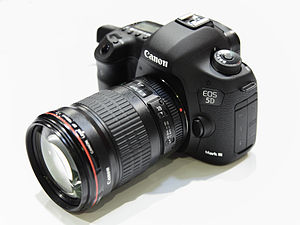Canon EOS 5D Mark III
 | |
| Overview | |
|---|---|
| Type | Digital single-lens reflex camera |
| Lens | |
| Lens | Interchangeable (EF) |
| Sensor/medium | |
| Sensor | 36 × 24 mm CMOS |
| Maximum resolution | 5760 × 3840 (22.1 megapixels) |
| Film speed | 100–25600 (expansion up to 102400) |
| Storage media | Dual slots: CompactFlash (CF) (Type I) and SD (SDHC, SDXC) |
| Focusing | |
| Focus modes | One-shot AF, AI Servo, AI Focus, Manual |
| Focus areas | 61 autofocus points, High-Density Reticular AF |
| Exposure/metering | |
| Exposure modes | Full auto, programmed, shutter priority, aperture priority, manual |
| Exposure metering | TTL, full aperture, 63 zones |
| Metering modes | Evaluative, Partial, Spot, Center-weighted average |
| Shutter | |
| Shutter | Electronic focal-plane |
| Shutter speed range | 30 to 1/8000 s, bulb, X-sync at 1/200 s |
| Continuous shooting | up to 6 frames per second |
| Viewfinder | |
| Viewfinder | Optical pentaprism with near 100% coverage[1] and electronic (Live View) |
| General | |
| LCD screen | 3.2 inches (81 mm), 1,040,000 dots |
| Battery | Li-Ion LP-E6 Rechargeable (1800mAh) |
| Optional battery packs | BG-E11 grip allows use of 6 AA cells, a single LP-E6 or two LP-E6 batteries |
| Weight | 860 g (1.90 lb) (body only) |
| Made in | Japan |
The Canon EOS 5D Mark III is a professional full-frame digital single-lens reflex (DSLR) camera made by Canon. It has a 22.3 megapixel CMOS image sensor.
Succeeding the EOS 5D Mark II, it was announced on 2 March 2012,[2] the 25th anniversary of the announcement of the first camera in the EOS line, the EOS 650. It was also Canon's 75th anniversary.[3] The Mark III went on sale later in March with a retail price of $3,499 in the US, £2999 in the UK, and €3569 in the Eurozone.[4]
Compared to EOS 5D Mark II
- 22.3MP Full-Frame CMOS Sensor (5760 × 3840 pixels), compared to 21.1 megapixels (5616 × 3744 pixels)
- DIGIC 5+ image processor, compared to DIGIC 4
- 100–25600 ISO (expandable to H1 (51200), H2 (102400)), compared to 100–6400 ISO (expandable to H1 (12800), H2 (25600))
- 61 Point AF + 41 Crosstype AF compared to 9 Point AF + 6 Assist Points. The Mark III's autofocus system is inherited from the recently announced EOS-1D X, and marks the first time since the EOS-3 film SLR that Canon has put its top-of-the-line autofocus system in a non-1-series body.[3]
- 6 frames per second continuous shooting compared to 3.9 frame/s
- TTL, full aperture, 63 zones compared to TTL, full aperture, 35 zones
- Silent, low vibration TTL shooting modes (single shot or 3 frames/s), compared to live-view-only silent shooting modes.
- 100% viewfinder, compared to 98% coverage
- Larger 3.2-inch (81 mm) LCD with 3:2 aspect ratio, compared to 3.0-inch (76 mm) at 4:3. In turn, this means that the native still images of the Mk III completely fill the screen, while the Mk II's native images are displayed with a black border on the bottom of the LCD. Also, while HD video remains letterboxed on the Mk III LCD, as on the Mk II, the 3:2 ratio allows more of the screen to be used for video display.[4]
- Headphone-out to monitor audio, the previous one having none.
- Dual card slots—one CompactFlash (CF) with full UDMA support, and one SD (including SDHC and SDXC cards, but does not exploit the UHS-I mode). The Mk II has only one CF slot.
- Eyecup Eg instead of Eb
Known defects
Canon issued a product advisory indicating that the camera's LCD panel, when illuminated in extremely dark environments, may impact the camera's light metering when shooting.[5] Any camera bodies sold with the issue will be fixed by Canon free of charge, and any body shipped after the first week of May 2012 likely had the defect already rectified.
Firmware updates
Firmware 1.2.1 was released on April 30, 2013 to allow the camera to output uncompressed video via HDMI and permit autofocus ability up to f/8.[6]
Firmware 1.2.3 was released on October 30, 2013, fixing a number of minor bugs.[7]
Firmware 1.3.3 was released on January 29, 2015, fixing minor menu issues and improved AF controllability when shooting in Live View mode with a wide-angle lens.
Notable works shot on Canon EOS 5D Mark III
Films
References
- ^ "Canon EOS 5D mark III — Specifications". Retrieved 2 March 2012.
- ^ "Canon U.S.A. Announces the Highly Anticipated EOS 5D Mark III Digital SLR Camera" (Press release). Canon U.S.A. 2 March 2012.
- ^ a b Westlake, Andy; Butler, Richard (March 2012). "Canon EOS 5D Mark III Hands-on Preview: 1. Introduction". Digital Photography Review. Retrieved 2 March 2012.
- ^ a b Laing, Gordon (March 2012). "Canon EOS 5D Mark III preview". CameraLabs.com. Retrieved 13 March 2012.
- ^ "Product Advisories". Retrieved 31 December 2012.
- ^ "EOS 5D Mark III firmware update". Canon. October 2012. Retrieved 28 January 2013.
- ^ "EOS 5D Mark III Firmware 1.2.3 Available". CANON RUMORS. 30 October 2013. Retrieved 15 November 2013.
- ^ "Briljante jaren 80 actiefilm 'Kung Fury' gefilmd met de Canon 5D III". FotoVideo.nu. 30 May 2015. Retrieved 2 June 2015.
External links
 Media related to Canon EOS 5D Mark III at Wikimedia Commons
Media related to Canon EOS 5D Mark III at Wikimedia Commons- EOS 5D Mark III Canon U.S.A. | Consumer & Home Office
